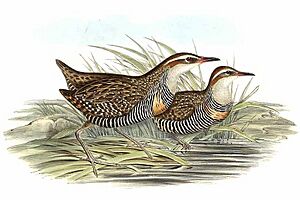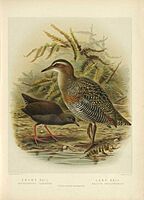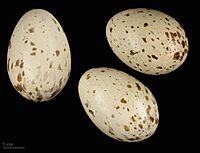Buff-banded rail facts for kids
Quick facts for kids Buff-banded rail |
|
|---|---|
 |
|
| Conservation status | |
| Scientific classification | |
| Genus: |
Hypotaenidia
|
| Species: |
philippensis
|
| Synonyms | |
|
|
The buff-banded rail (Hypotaenidia philippensis) is a colorful, medium-sized bird. It belongs to the Rallidae family, which includes rails and coots. These birds are known for traveling long distances.
You can find different types, called subspecies, of the buff-banded rail across many parts of Australasia and the southwest Pacific region. This includes places like the Philippines, New Guinea, Australia, and New Zealand. In New Zealand, it's known as the banded rail or moho-pererū in Māori.
Contents
How the Buff-Banded Rail Got Its Name
In 1760, a French zoologist named Mathurin Jacques Brisson first described this bird. He also drew pictures of it. He based his description on a bird from the Philippines.
Later, in 1766, a famous Swedish scientist named Carl Linnaeus updated his book Systema Naturae. He added many new species, including the buff-banded rail. Linnaeus gave it the scientific name Rallus philippensis. This is how the bird got its official two-part name.
The buff-banded rail used to be in a group called Gallirallus. But now, scientists have placed it in a different group, or genus, called Hypotaenidia. This change happened in 1853.
Many Types of Buff-Banded Rails
There are many different types, or subspecies, of the buff-banded rail. This is because these birds often fly to new islands in the Pacific. When they arrive, a small group starts a new population. Over time, these island groups can become quite different from their relatives elsewhere.
For example, the weka bird in New Zealand is related to the buff-banded rail. But the weka has changed over time and can no longer fly.
Some of the recognized subspecies include:
- H. p. andrewsi from the Cocos (Keeling) Islands
- H. p. philippensis from the Philippines and other islands
- H. p. christophori from the Solomon Islands
- H. p. mellori from Australia and the Moluccas
What Does the Buff-Banded Rail Look Like?

This bird is about the size of a small chicken. It mostly lives on the ground. Its upper parts are brown. Its belly has fine black and white stripes. It has a white stripe above its eye. There's also a chestnut-colored band that goes from its beak around the back of its neck. A buff-colored band crosses its chest.
Buff-banded rails like to live in wet areas or wetlands. They prefer places with low, thick plants where they can hide. They are usually quite shy. However, in some places, like island resorts, they can become very brave and friendly.
How Buff-Banded Rails Live
The buff-banded rail is an omnivorous scavenger. This means it eats both plants and animals, and it also looks for leftover food. It eats small creatures without backbones, like insects. It also eats small animals with backbones, seeds, fallen fruit, and other plant materials. Sometimes, it will even eat dead animals or trash.
Their nests are usually built in thick grass or reeds. They like to build their nests close to water. A female buff-banded rail usually lays 3 to 4 eggs at a time.
Some groups of these birds on islands might be in danger. This is often because of animals brought to the islands by humans, like cats or rats, that hunt them. However, as a whole, the buff-banded rail species is doing well. Its conservation status is considered to be of Least Concern, which means it's not currently at risk of disappearing.
Images for kids
-
A buff-banded rail on Fafa Island, Tonga.






